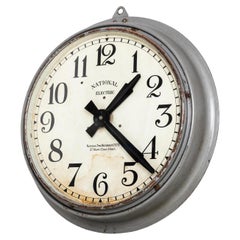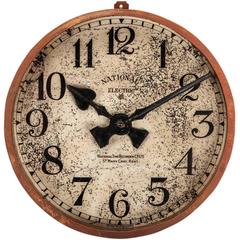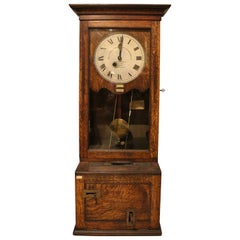Time Recorder Clock
Vintage 1950s English Industrial Wall Clocks
Brass
Recent Sales
Vintage 1920s English Industrial Wall Clocks
Iron, Metal
20th Century Great Britain (UK) Machine Age Wall Clocks
20th Century Machine Age Wall Clocks
Early 20th Century American Wall Clocks
Metal
Antique Late 19th Century American Industrial Scientific Instruments
Oak
People Also Browsed
Vintage 1980s Japanese Industrial Wall Clocks
Steel, Cut Steel, Chrome
Early 20th Century Japanese Art Deco Wall Clocks
Glass, Wood
Antique 19th Century Dutch Folk Art Bird Cages
Wood
Antique 1720s Spanish Baroque Beds and Bed Frames
Giltwood, Paint
Vintage 1920s English Industrial Wall Clocks
Glass, Mahogany
Finding the Right Wall-clocks for You
Antique, new and vintage wall clocks have become available over the years in a diverse range of materials, such as wood, metal and glass, as well as styles from mid-century modern to Industrial.
Wall clocks have been designed by acclaimed creators and manufacturers such as Howard Miller Clock Company, Junghans Uhren GmbH, Pragotron and more. The Ball clock and Sunflower clock, which were created by designer Irving Harper in George Nelson’s studio during the mid-century era, are known to design enthusiasts and have become highly collectible over the years.
Whether you want an antique timepiece or one that will match a modern motif, you are sure to find one to suit any home or office decor.
The wall clocks of today have come a long way from the mechanical timepieces that originated in the 14th century. One of the most famous clocks from this era was made by Italian astronomer and physician Giovanni de’ Dondi and took approximately 16 years to complete. By the 17th century, wall clocks were popular luxury objects for the home.
Wall clock choices are not limited to just something that keeps time. A 19th-century bronze cartel clock and barometer set is an elegant addition to a foyer, while a vintage world-map clock allows you to see the time in several locations at once. Cleverly designed clocks have been created for all manner of tastes over the years.
On 1stDibs, you will find wall clocks and other types of antique and vintage clocks from various time periods, from Louis XV to Art Deco, and from all over the world, including Germany, France, the United Kingdom and elsewhere. Bring a touch of class and personality into your living room or dining room with a unique timepiece.
- 1stDibs ExpertFebruary 13, 2023Old-time record players were called gramophones or phonographs. Thomas Edison debuted his phonograph in 1877. The device was the result of Edison’s developing improvements to the telegraph and the telephone. He worked out a way to record sound on cylinders that were coated in tin foil (he decided that his invention would “undoubtedly be liberally devoted to music”). On 1stDibs, find vintage record players.
Read More
How a Craving for Color Revolutionized Glass
After synthetic dyes changed fashion, home goods and printed matter, it was only a matter of time till glass caught up.
Kazuyo Sejima’s Flowering Tree Blooms Year-Round
The brilliantly simple design turns a modest bouquet into a major statement.
He Wrote ‘Oedipus Rex,’ but Do You Know What He Looked Like?
The Greek tragedian is said to have been handsome in his day.
Cigar Culture Was Once the Peak of Masculinity. Now, It’s a Compelling Curiosity
Even for those who don’t indulge, elegant smoking accessories and audacious art portraying cigar enthusiasts hold a nostalgic allure.
African Travel Plans on Hold? This Ardmore Leopard Vase Brings the Beauty of the Savanna to You
It’s an excellent example of the sought-after ceramics coming out of South Africa’s KwaZulu-Natal province.
With a High-Tech Flagship and Cool Collabs, Lladró Is Breaking the Mold for Porcelain Production
Thanks to its new leadership, the Spanish maker of figurines, busts and lighting is on a mission to update the art of porcelain for the 21st century.
Zoë Powell’s Magnolia 05 Vessel Is Handmade from Clay She Unearthed Herself
The free-form stoneware piece is inspired by the magnolia tree and its associations with home.
8 Ways to Breathe New Life into a Space with Plants
The pair behind the Instagram account @houseplantclub share their tips for making any room of the house gloriously green.


